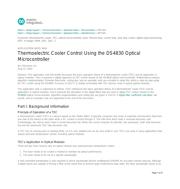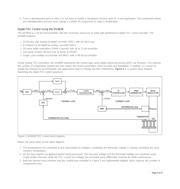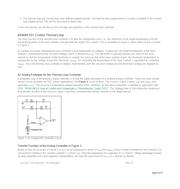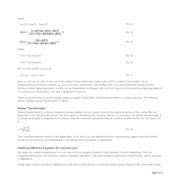herunterladen

Maxim > Design Support > Technical Documents > Application Notes > Microcontrollers > APP 5424
Maxim > Design Support > Technical Documents > Application Notes > Optoelectronics > APP 5424
Keywords: thermoelectric cooler, TEC, optical microcontroller, laser, thermal loop, current loop, dual loop control, digital signal processing,
DSP, H-bridge, PWM, ADC, DAC, C
APPLICATION NOTE 5424
Thermoelectric Cooler Control Using the DS4830 Optical
Microcontroller
By: Shoumin Liu
Aug 17, 2012
Abstract: This application note first briefly discusses the basic operation theory of a thermoelectric cooler (TEC) and its application in
optical modules. Then it presents a digital approach to TEC control based on the DS4830 optical microcontroller. Mathematical analysis,
algorithm implementation, firmware flowcharts, coding tips, and an example code are included to make this article a step-by-step guide
for TEC control using the DS4830. Accuracy of ±0.1°C is readily achievable with TEC devices used in typical optical modules.
This application note is organized as follows. Part I introduces the basic operation theory of a thermoelectric cooler (TEC) and its
application in optical modules. Part II presents the derivation of the digital filters that are used in digital TEC control, based on the
DS4830 optical microcontroller. Algorithm implementation and coding tips are given in Part III. A digital filter coefficient calculator, lab
results, and an example code are appended to the end of the document.
Part I: Background Information
Principle of Operation of a TEC
A thermoelectric cooler (TEC) is a device based on the Peltier effect. It typically comprises two kinds of materials and transfers heat from
one side of the device to the other while a DC current is forced through it. The side from which heat is removed becomes cold.
Contrastingly, the side to which heat is moved becomes hot. When the current reverses its direction, the previously "cold" side becomes
hot and the previously "hot" side becomes cold.
A TEC has no moving parts or working fluids, so it is very reliable and can be very small in size. TECs are used in many applications that
require precision temperature control, including optical modules.
TEC's Application in Optical Modules
There are two main reasons why an optical module may need precision temperature control.
1. The laser needs to be cooled or heated to maintain its optical performance.
2. The laser needs to be set at a specific wavelength.
A well-controlled temperature is also required in dense wavelength division multiplexing (DWDM) for accurate channel spacing. Although
multiple lasers are capable of driving a fiber at the same time to achieve large multichannel data rates, the laser wavelength needs to be
Page 1 of 27








